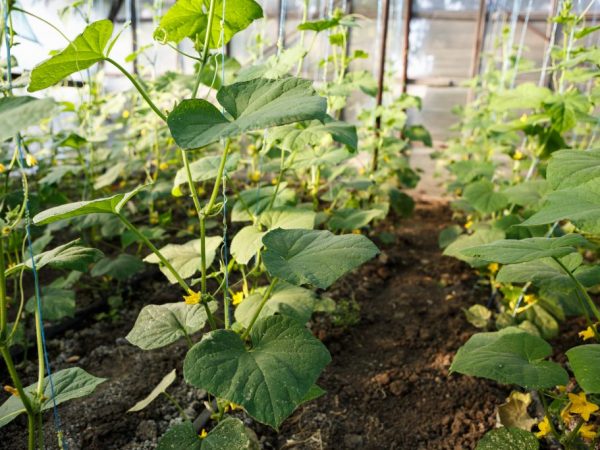Characteristics of the variety of cucumbers The Little Humpbacked Horse
Among the different types of vegetable crops, the Humpbacked Horse cucumber variety deserves special attention.

Characteristics of the variety of cucumbers The Little Humpbacked Horse
Variety characteristic
Belonging to F1 hybrids gives the Humpbacked Horse variety a number of positive qualities: good yield and resistance to negative external factors, as well as self-pollination.
Description of bushes
The height of the bush does not exceed 1.5 m on average. The hybrid forms up to 15 fruits at a time. In its nodes, no more than 7-8 ovaries are formed. The fruits are harvested 46 days after sowing. Also, the belonging of the bush to F1 hybrids saves it from most diseases. The bush is dominated by the female type of flowering.
Description of the fetus
The size of the fruit reaches 12 cm, weight - 90 g. Cucumber The Humpbacked Horse F1 has a thin peel covered with medium-sized tubercles.
According to the description, the fruit is characterized by juicy pulp and lack of bitterness. Cucumbers F1 Humpbacked Horse are useful for consumption, because they contain a large amount of vitamins and substances that cleanse the blood and stomach.
Care
If you follow all the rules of care, problems with diseases and pests will not arise.
Planting care
Seeds are planted in early April. The grains of cucumbers are planted, having previously treated them with a solution of water and useful minerals. Small pots with good soil are recommended. After fertilizing the soil, the seeds are planted to a depth of about 3 cm. The soil is watered every day, without overdoing it, so that the soil does not acidify.
Care after landing
Proper care of the Little Humpbacked Horse assumes compliance with the basic rules. On the site, the remains of other vegetation, dirt, weeds are removed. When the bush is old enough, it is tied to a trellis to give support. During the development period, the bush is fed. Without proper care, the plant can become sick or die.
Pests and diseases

Pests can be dealt with
Pests
- The whitefly is a small white midge that drinks the sap of plants and leaves behind sooty mushrooms. A solution of garlic and water (150 g of garlic per 1 liter of water), which is sprayed on cucumbers, helps against whitefly.
- Aphids like to settle in colonies on leaves and eat them. The consequences of her sabotage are wilting of leaves. A solution of wood ash, soap and water helps against aphids (50 g of wood ash and 20 g of soap are added to 2.5 liters of water).
- Spider mites are small mites that leave cobwebs under the leaves, where they sit. Spraying with soapy water (1 tablespoon of soap per 1 liter of water) on the back of the leaves helps against them.
If pests have settled on one bush, you need to try to exterminate them before they move on to the rest.
More effective in the fight against parasites are branded drugs "Tanrek", "Actellik", "Komandor", "Fitoverm", "Vofatox", "Kinmiks" and others.
Diseases
Diseases most often appear due to the carelessness of the site owners.
- Powdery mildew. White spots appear on the leaves, gradually spreading throughout the plant.Because of it, the leaves dry out and fruiting stops. To combat the disease, the infected parts are cut off, the plants are sprayed with fungicides (10 g of fungicides per 5 liters of water). With a strong spread of the disease, the bush is destroyed.
- Cladosporium. Brown ulcers appear on the plant and the fruit looks rotten. To combat, watering the plants is stopped for 5 days and treated with foundation (10 g of foundation per 0.5 l of water). The affected parts of the bush are removed.
- White rot. It is a viscous white consistency that causes the fruit and the bush itself to rot. The affected parts of the plant are removed, the bush is treated with a solution of urea, water, zinc sulfate and copper sulfate (10 g of copper sulfate, urea, zinc sulfate per 2 liters of water).
- Downy mildew. Small yellow spots on the leaves. The disease causes drying of the leaves, and then the whole plant. Stopping watering and feeding for 3-4 days, as well as subsequent treatments with polycarbacin (10 g per 5 L of water) will help in the fight against this disease.
- Yellowing of the leaves. The usual yellowing of the leaves is often due to a lack of potassium. Spraying the plant with an infusion of ash (200 g per 2.5 liters of water) helps to cope with this.
It is necessary to ensure that the disease does not pass from a sick plant to healthy ones.
If the disease has gone too far, there is only one option - to get rid of the landing.
Conclusion
The F1 Humpbacked Horse cucumber is an excellent variety that does not cause a hassle if you follow the basic rules of caring for it.


